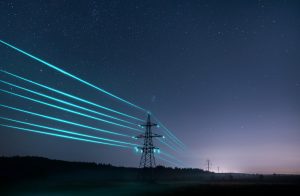When you install a surge protector, the golden rule to bear in mind for cable lengths and clearance distances is “the shorter, the better”
Length and distance determines surge arresters’ overvoltage absorption capacity
When you install a surge arrestor, the single most critical parameter is cable length – to the mains network and to the piece of equipment it is supposed to protect.
Surge arresters’ cable lengths are like good jokes. The shorter, the better. Unlike jokes, however, lengths are no laughing matter. The reason? A cable that’s too long can destroy a load. Under fast rise time conditions, inductance increases and causes high transient voltages to build up in long cables.
Indeed, the shorter the connection, the more effective the protection. More than any other parameter cable length determines a surge arrester’s ability to dissipate overvoltage up to a given value.
The 50-centimetre installation rule
A rule of thumb for the length of a cable between the surge arrestor and the mains network is the so-called “50 centimetre rule”. Similarly, the cable connecting the arrestor to a piece of equipment should be no longer than 10 metres.
On the other hand we need to consider that sensitive electrical equipment is destroyed if its rated impulse withstand voltage (Uw) exceeds 1500V, (Uw, impulse withstand voltage assigned by the manufacturer to the equipment or to a part of it, characterizing the specified withstand capability of its insulation against overvoltages).
Anything above that and the load is destroyed.
Let’s take, for example, a surge arrestor with a cable connection to earth that is total of 1m long. If a 10kA lightning impulse current runs through it for 10 microseconds, the potential difference between its two ends is 1000 V.
Figure 1. Breaking the 50 centimetre ruleHowever, the 1000 V come on top of the 1500 V maximum potential difference of the surge arrester’s voltage protection level (Uspd) and its disconnect circuit breaker (Udisconnector). The sensitive load will think the overvoltage from the lightning current is, say, 2500 V. And because its impulse withstand voltage is only 1500 V, it will be vaporized.
The answer is to shorten cable lengths, as Figure 2 shows, in 3 steps.
Figure 2. Shortening surge arrestor cables- Connect the surge protector as close to the power network’s earth terminal block as possible.
- Mount the circuit breaker. The most effect arrangement is a surge arrestor that incorporates a disconnect circuit breaker.
- Install an intermediate earthing terminal as close as possible to the SPD earth terminal block, then connect it to the main earthing protection cable from the ground. Run another cable from the intermediate earthing terminal to the SPD earth terminal block and connect the intermediate earthing terminal to the main earthing terminal.
The 10 meters installation rule
The same principle applies to cables between surge arresters and pieces of equipment. If they are longer than 10 meters, you should install a second surge arrester as close as you can to the equipment. Use the same brand of surge arrestor and stick to the manufacturer’s coordination table.
And don’t forget. Transients can slip into a building or facility through phone lines, computer networks, CCTV systems – you name it. So, install surge arrestors on any device or system that is prone to overvoltage or is particularly sensitive.
Standards to apply
Although you install surge protection devices in accordance with national standards (e.g. France NF C 15-100, Spain REBT, Italy CEI 99), all countries apply international standard IEC 60364. And all national regulation incorporate sections of IEC 60364 according to their needs.



Conversation
thanks for the explanation of the reason behind the 10 metre rule. Helps no end when explaining to students. Cheers
Hello,
I am the owner of a small bakery in Toronto Canada.
My equipment includes a gas fired multi deck baking oven.
Although the oven is gas fired it does depend on several electric motors to distribute heat and vent off excess fumes and steam. The oven has it’s own electrical panel (with IP54 degree of protection) and several fuses that trip easily when there are any electrical events such as outages and surges. After a series of ice storms here in Toronto last winter there were numerous power outages, a month or so later the main blower motor in the oven stopped working. The oven was KAPUT and my business suffered an interuption that lasted several days. I located an electric motor repair service, removed the defunct blower motor and had it repaired (it was actually rewound). Once reinstalled it has worked perfectly ever since. However there has remained an element of doubt in my mind and I have begun to search the possiblility of installing a surge protector at the main electrical panel. The oven’s electrical components are 3 phase, except for the lighting system which is single phase. Can you please make a recommendation in regards to whether or not installing a surge protection device will assist in protecting the oven’s electrical components from surges?
Many thanks!
-David Aplin
I am basically non technical and I want details of lightening arrestor installing procedure.
It building height is 30 meters what radius LA can cover if thunders resumes.
Thunder arestor / eat road. The processing of thunder arestor from the grounds, is it possible and Right to Connect eart yellowcable from the Thunder arestor cuper from the grounds, If I do pleas tell me what we be the implications, thanks.
Thunder arestor / eart road. The processing of thunder arestor from the grounds, is it Right to Connect eart yellowcable board from the Thunder arestor cuper from the grounds, If I do pleas tell me what we be the implications, thanks.